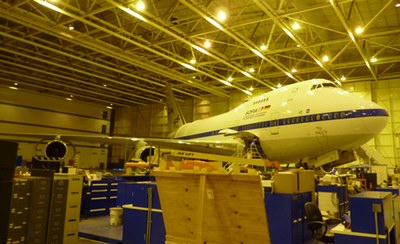
The
SOFIA aircraft in NASA’s Dryden Aircraft Operations Facility in
Palmdale, California, being prepared for science flights to start in the
next several months. (credit: J. Foust)
by Jeff Foust
Monday, January 21, 2013
Air Force Plant 42 may be largely unknown by the general public, but it has a long and storied history in aerospace circles. Located in Palmdale, California, in the high desert northeast of Los Angeles and south of Edwards Air Force Base, Plant 42 is a government-owned airfield that hosts, or has adjacent to it, manufacturing facilities for several aerospace companies, including Lockheed Martin’s Skunk Works. During the Cold War, these facilities built a number of famous aircraft, from the SR-71 to the B-2. Plant 42’s Site 1 was where Rockwell (now part of Boeing) assembled all the Space Shuttle orbiters, from Enterprise to Endeavour.
“NASA got a sweet deal on the lease of this building” when it moved in late in 2007, said Eddie Zavala, SOFIA program manager, during a tour of the hangar earlier this month. (Prior to NASA moving in, he said, the hangar had been used as a soundstage for several films, including The Terminal and one of the installments in the Pirates of the Caribbean series.) “We’ll be in this building for the life of the program, and SOFIA’s lifecycle is estimated to be 20 years.” And that lifecycle, as measured by the beginning of regular science operations, is finally getting underway.
SOFIA is one example of a science project that is simple in concept but dauntingly complex in execution. Ground-based infrared astronomy is hampered by the presence of atmospheric constituents, particularly water vapor, that absorb infrared light. Putting the telescope in space avoids that problem, of course, but an alternative that is nearly as effective as, but less expensive and more flexible than, a spacecraft is to mount a telescope in an aircraft that flies in the stratosphere, above most atmospheric water vapor. NASA has demonstrated this approach with several aircraft, most notably the Kuiper Airborne Observatory (KAO), a converted C-141 cargo plane with a 91-centimeter (36-inch) telescope that operated from the mid 1970s to the mid 1990s.
More - Link >>> http://www.thespacereview.com/article/2220/1
Source: The Space Review.
gaw
Glenn A. Walsh, Project Director,
Friends of the Zeiss < http://friendsofthezeiss.org >
Electronic Mail - < gawalsh@planetarium.cc >
About the Author: < http://buhlplanetarium.tripod.com/#GAW >
SPACE & SCIENCE NEWS, ASTRONOMICAL CALENDAR:
< http://buhlplanetarium.tripod.
Twitter: < http://twitter.com/
Facebook: < http://www.facebook.com/pages/
Blog: < http://spacewatchtower.
Author of History Web Sites on the Internet --
* Buhl Planetarium, Pittsburgh:
< http://www.planetarium.
* Adler Planetarium, Chicago:
< http://adlerplanetarium.
* Astronomer, Educator, Optician John A. Brashear:
< http://johnbrashear.tripod.com >
* Andrew Carnegie & Carnegie Libraries:
< http://www.andrewcarnegie.
* Civil War Museum of Andrew Carnegie Free Library:
< http://garespypost.tripod.com >
* Duquesne Incline cable-car railway, Pittsburgh:
< http://inclinedplane.tripod.
* Public Transit:
< http://andrewcarnegie2.tripod.
No comments:
Post a Comment